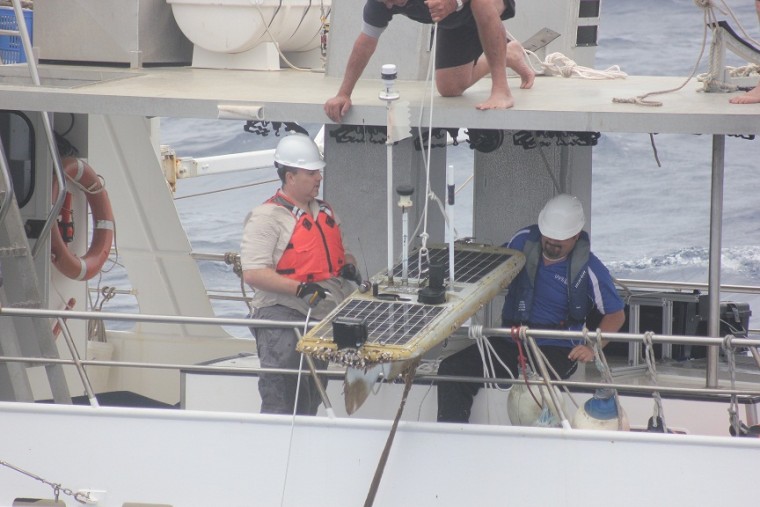
A robotic wave glider recently pulled into an Australian bay, marking the end of a record-setting 9,000-nautical-mile journey in the name of science and technology.
The Papa Mau robot is one of four wave gliders launched from San Francisco on Nov. 17, 2011. En route, it weathered gale-force winds, fended off sharks and gathered an unprecedented amount of data on weather and ocean conditions that is now available online for anyone to use.
The journey set a new world record for the longest distant traveled by an autonomous vehicle, according to Liquid Robotics, the venture behind the ocean-crossing stunt. But that milestone pales in comparison to what the feat represents.
"By having a robot that can go out into the ocean and essentially stay there, a year-long duration, 9,000-nautical-mile mission, what we've done is opened up access to the ocean surface for relatively low cost," Graham Hine, senior vice president for product management at Liquid Robotics, told NBC News.
The ability to unleash an autonomous data-collecting robot out in the ocean for months – perhaps even years – on end means scientists can learn much more about the little-known stretches of our planet considered essential for governing the global climate and helping to feed the world.
The four wave gliders reached Hawaii in March and, after a little island rest and relaxation, diverged toward Australia and Japan. One Asia-bound robot malfunctioned and is headed back to Hawaii for repairs. The other two are expected to arrive at their destinations in 2013. Eventually, the fourth may complete its mission too.
Once all four robots are recovered, Liquid Robotics anticipates their scientific explorations to continue.
"I'd like to see further studies of the Southern Ocean, I'd like to see circumnavigation of Antarctica, I'd like to see us go from the South Pole to the North Pole. I'd like to see us maybe pilot the Northwest Passage," Hine said.
Papa Mau and its cousins consist of underwater and surface pieces connected by a 23-foot long cable. The underwater wing-like system, the glider, converts wave energy into thrust while the solar panels on the 7-foot long surface float harvest electricity to power sensors.
The sensors measure things such as temperature, salinity and wave heights, and transmit the data to shore via satellites. Over the course of their journey, the robots are expected to collect and transmit 2.25 million discrete data points.
Among the Papa Mau’s more intriguing encounters was a 1,200-mile-long algal bloom along the Equatorial Pacific, Hine said.
These blooms are typically monitored with satellites. The robot’s in-situ measurements will allow scientists to validate their models. Algal blooms are a major component of the ocean food chain and help regulate the global climate.
"This sort of ocean measurement changes the way you understand something," Hine said.
Liquid Robotics will soon award a $50,000 research grant to the scientist with the most interesting proposal on how to use six months of wave glider time. Projects proposed among the five finalists range from measuring ocean health and respiration to studying ocean biomass.
Check out a video of the Papa Mau’s arrival below.
– via CNET
John Roach is a contributing writer for NBC News Digital. To learn more about him, check out his website. For more of our Future of Technology series, watch the featured video below.